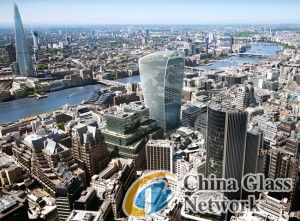Post Time:Sep 09,2013Classify:Industry NewsView:339
 That’s just what Londoners are dealing with now in the wake of this week’s news that heated sun reflections from the yet-to-be-completed, 38-story glass tower at 20 Fenchurch Street had melted part of a Jaguar sedan parked on a nearby street and even been the source of several fires in the area.
That’s just what Londoners are dealing with now in the wake of this week’s news that heated sun reflections from the yet-to-be-completed, 38-story glass tower at 20 Fenchurch Street had melted part of a Jaguar sedan parked on a nearby street and even been the source of several fires in the area.
The story has taken on a life of its own, generating talk and media coverage everywhere.
“We are taking the issue of light reflecting from the 20 Fenchurch Street seriously,” says a joint statement from the building’s two developers, Land Securities and Canary Wharf, “and are looking into the matter as a priority.”
Owners of the building, which has been nicknamed “Walkie Talkie” because of the distinctive shape given to it by Uruguayan architect Rafael Vinoly, have agreed to pay for damages to the sports car and quickly constructed a scaffold screen at street level to temporarily minimize damage to the surrounding area until permanent corrections can be made. Three parking bays in the area have also been closed as a precaution.
Critics have mockingly referred to the building as a “fry-scraper,” but its developers still contend the problem is a short-term one.
“The phenomenon is caused by the current elevation of the sun in the sky,” says the statement. “It currently last for approximately two hours per day, with initial modeling suggesting that it will be present for approximately two to three weeks.”
It is unclear what kind of glass was used on the building or who installed it, as efforts to reach the New York-based Vinoly were unsuccessful as of Friday afternoon.
“Fundamentally, it’s reflection,” Chris Shepherd of the Institute of Physics told the BBC. “If a building creates enough of a curve with a series of flat windows, which act like mirrors, the reflections all converge at one point, focusing and concentrating the light.”
That’s been the problem in London, the second as such for Vinoly, whose crescent-shaped Vdara Hotel in Las Vegas was infamously known as “Death Ray Hotel” when it opened in 2009 after guests complained that a 15-square meter of the pool deck was hot enough to singe their hair and melt plastic. The hotel has since added anti-reflective film, rows of umbrellas and even large plants to cure the problem.
Other buildings have also experienced such problems. Upon its opening in 2003, Frank Gehry’s Walt Disney Concert Hall was forced to have some of its burnished stainless steel panels sanded down to prevent drivers from being blinded by the glare and pedestrians blinded by pavement hotspots that reached 140 degrees Fahrenheit (60 degrees Celsius).
Earlier this year, Museum Tower, a condo-filled skyscraper in Dallas, was literally a source of friction to the nearby Nasher Sculpture Center, which claimed the intense sunlight reflecting off the Museum Tower was killing the plants in its sculpture garden and ruining exhibits. The museum removed a Picasso painting from display over concerns that direct sunlight would damage it.
Land Securities and Canary Wharf say they are “responsible developers” making every effort to do right by their neighbors.
“We have liased extensively with local businesses to keep them informed throughout,” they say in their statement. “We have decided on this course of action with their input and agreement.”
Source: http://www.usglassmag.com/2013/09/london-skyscrapeAuthor: shangyi
PrevSun Tech Glass Tinting Expands Window Services in Houston, Texas
Price of Online ultra-clear low-e glass on Sep. 9. 2013 from China Glass NetworkNext